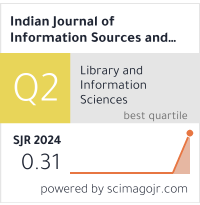Economics Research Output in BRICS Countries: A Scientometric Dimension
DOI:
https://doi.org/10.51983/ijiss.2019.9.1.603Keywords:
Economics, Research Output, BRICS Countries, Scientometric DimensionAbstract
This article examines the research output of economics published by BRICS countries during 1991-2016. Data collected from the Web of Science database. Growth rate (CAGR), Collaboration index, Transformative Activity index (TAI), Co-authorship index and Relative Citation Impact (RCI) indicators have been adopted to analyze the quantity and impact of economic research. We found that all five BRICS countries contributed approximately 10 percentile of the world’s economics research. The highest contribution was made by China with a total of 4424 articles which is 40.59 percent. Russia has the maximum growth rate of 27.99. Overall collaboration rate of economics publications of BRICS countries is moderate.
References
Amid BRICS’ rise and ‘Arab Spring’, a new global order forms. (2011, 18 October). Christian Science Monitor.
Balasubramani, R., Siriwardena, A., & Abu, K. (2015). Science Funding Research Output in BRIC Countries: A Scientometric Analysis. 10th International CALIBER-2015 HP University and IIAS, Shimla, Himachal Pradesh, India March 12-14, 2015 © INFLIBNET Centre, Gandhinagar, Gujarat, India.
Bartosova, J., & Bina, V. (2010). Influence of the relative poverty on the structure of household expenditures in the Czech Republic. In ICABR 2008–VI. International conference on applied business research Ras Al Khaimah 29.11. 2010–03.12, 19–28.
Biradar, N., & Tadasad, P. G. (2015). Authorship patterns and collaborative research in economics. Journal of Indian Library Association, 51(4), 21-29.
Chitra, V., Jeyshankar, R., & Abu, K. (2014). Lung Cancer Research in G7 and BRIC Countries: A Comparative Analysis by Scientometric Method. International Journal of Advanced Library and Information Science, 2(1), 72-81.
Elango, B., Rajendran, P., & J, M. (2013). Tribology Research Output in BRIC Countries: A Scientometric Dimension. Library Philosophy and Practice (e-journal), 935.
Guan, J. C., & Ma, N. (2007). A bibliometric study of China’s semiconductor literature compared with other major Asian countries. Scientometrics, 70(1), 107-124.
Kumar, N., & Asheulova, N. (2011, September). Comparative analysis of scientific output of BRIC countries. Annals of Library and Information Studies, 58, 228-236.
Lalitha Kumar, G. (2009). Synthetic Organic Chemistry Research: Analysis by Scientometric Indicators. Scientometrics, 80(3), 559-570.
Savanur, K. P., & Srikanth, R. (2010). Modified collaborative coefficient: a new measure for quantifying the degree of research collaboration, Scientometrics, 84, 365-371.
Savanur, K. P., & Bakanatti, S. (2018). Scientometric Study of Mathematics research among BRICS Countries as reflected in Web of Science database during 2011-2015. Journal of Library Development (JLD), 4(2), 25-29.
Schubert, A., & Braun, T. (1986). Relative indicators and relational charts for comparative assessment of publication output and citation impact. Scientometrics, 9, 281–291.
Shashnov, S., & Kotsemir, M. (2018). Research landscape of the BRICS countries, Scientometrics, 117, 1115-1155.
World Economic Outlook (2013). IMF. April 2013.
Wikipedia, accessed Dec. 2018. Retrieved from https://en.wikipedia.org/wiki/BRICS#cite_note-IMFApr2013-8
Yang, L. Y., Yue, T., Ding, J. L., & Han, T. (2012). A comparison of disciplinary structure in science between the G7 and the BRIC countries by bibliometric methods. Scientometrics, 93(2), 497–516.
Yi, Y., Qi, W., & Wu, D. (2013). Are CIVETS the next BRICs? A comparative analysis from scientometrics perspective. Scientometrics, 94(2), 615–628.
Downloads
Published
How to Cite
Issue
Section
License
Copyright (c) 2019 The Research Publication

This work is licensed under a Creative Commons Attribution-NonCommercial-NoDerivatives 4.0 International License.









